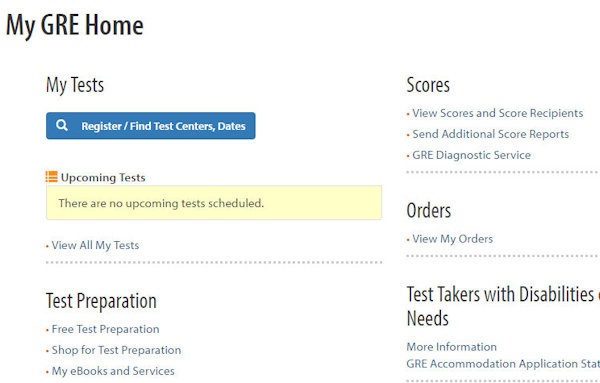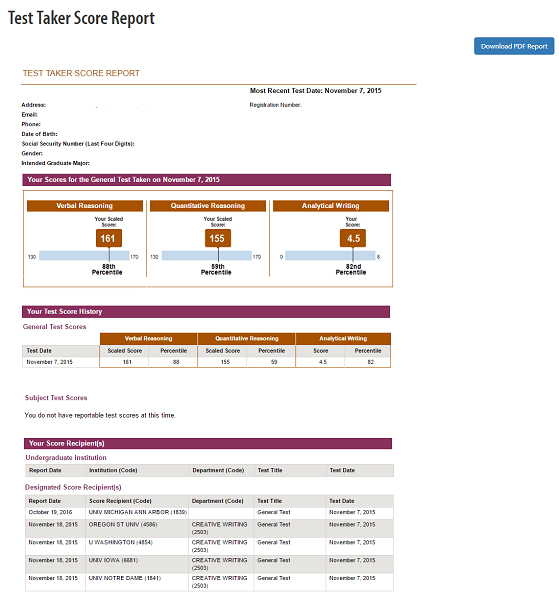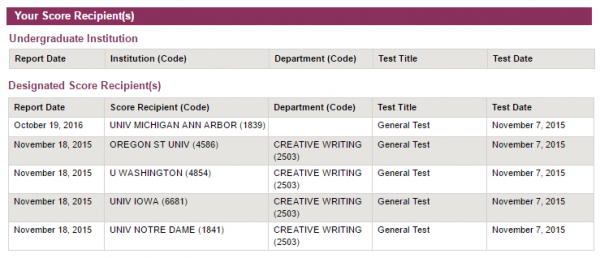
Taking the GRE can be a terrifying endeavor, but sometimes it’s looking at the score report that is the ultimate test of courage. Unfortunately, even after you calm your nerves enough to look at your score, you can still end up confused. What exactly does a GRE score report contain? How can you tell if you scored well on the GRE?
In this article, we’ll explore everything you need to know about the ETS GRE score report. Together, we’ll take a look at the various sections of the GRE score report, go over what your schools see on their score reports, and discuss the different methods for sending scores to your schools on and after test day.
GRE Score Report: Overview
You’ll receive your official ETS GRE score report about 10-15 days after taking the GRE (five weeks for the paper version of the test). Your score report can be accessed online through your ETS Account (we’ll cover exactly where to find the report in a moment).
At present, GRE score reports are only available electronically, meaning you will not receive a copy of your score report by mail. The only way to get a hardcopy is by directly downloading a PDF version of your score report and then printing it out.
There is no full GRE unofficial score report, but your unofficial Verbal Reasoning and Quantitative Reasoning scores will be given to you on-screen directly after you take the GRE. These scores are not your official scores and may differ slightly from the scaled scores on your official score report. (But this is somewhat rare. Most of the time, your unofficial scores will be identical to your official scores.) Additionally, there is no unofficial score for the Analytical Writing (AW) section; the only AW score you’ll receive is the official one on your GRE score report.
Where to Find Your GRE Score Report
10-15 days after taking the test (five weeks for the paper version), ETS will send you an email notification telling you your official score report is available online. At this time, ETS will also send your free score reports to whatever score recipients you designated on test day (if any).
Quick side note: we've created the world's leading online GRE prep program that adapts to you and your strengths and weaknesses. Not sure what to study? Confused by how to improve your score? We give you minute by minute guide.
You don't NEED a prep program to get a great GRE score. But we believe PrepScholar is the best GRE prep program available right now, especially if you find it hard to organize your study schedule and don't know what to study.
Click here to learn how you can improve your GRE score by 7 points, guaranteed.
To view your ETS GRE score report, log on to your ETS Account. You’ll see the following homepage:

Click “View Scores and Score Recipients” to get to a page titled “Test Taker Score Report.” Here, you can view your scores for Verbal, Quant, and AW, as well as your percentiles and other test-taking information. We’ll cover the specifics of your score report shortly.
If you want, you can download a PDF version of your score report by clicking the blue button that says “Download PDF Report” in the top-right corner of the page. The PDF version of your score report is identical in content to your online score report and even includes any recent changes or orders you’ve placed for additional score reports.
If you can’t find your GRE scores on your ETS Account, chances are your scores are still being processed. Unfortunately, there is no rush reporting option for the GRE as there is for the SAT, so your only choice is to sit tight and wait for the email notification.

What’s on Your GRE Score Report?
Online, your official GRE score report will look like this:

It’ll begin with an overview of your personal information, including:
- Your name
- Your most recent test date
- Your address
- Your email
- Your phone number
- Your date of birth
- The last four digits of your social security number (if supplied)
- Your gender
- Your intended graduate major (if supplied)
- Your registration number
The bulk of it, however, will cover the following test-related content (divided into three separate sections):
- Your scores and percentiles for Verbal, Quant, and AW
- Your test score history for the general GRE and any GRE subject tests you’ve taken
- Your score recipients (including those you ordered scores for on test day and after test day)
Your Scores and Percentiles
The first thing you’ll come across on your GRE score report, after your profile information, is a snapshot of your scores and percentiles for each GRE section:

Both the Verbal and Quant sections are scored using 1-point increments on a scale of 130-170. On this scale, 130 is the lowest possible score and 170 is the highest possible score. For the AW section, scores are calculated using half-point increments on a scale of 0-6, with 6 being a perfect score. To learn more about how GRE sections are scored, check out our in-depth guide.
Percentiles, on the other hand, tell you what percentage of test takers you scored higher than in a given section. So a 25th percentile score is below average, a 50th percentile score is exactly average, and a 99th percentile score is exceptional. In short, the higher your percentile, the more impressive your score is.
Percentiles aren’t everything, though. In reality, how good your GRE scores are depends on a combination of several factors, including how long you studied for the test, what field of study you’re planning to enter, and what programs you’re applying to. Most test takers usually try to aim for average or above average.
But average GRE scores can vary greatly by school and intended graduate major, too. Therefore, if you’re curious about how your scores stack up against those of other test takers, make sure you’re comparing them with the most relevant averages available and not only the overall averages.
A good score also depends on what your goal scores are. Try not to feel too disheartened if one or a couple of your scores aren’t as high as you thought they’d be. In the end, you can always retake the GRE or send an entirely different set of GRE scores to your schools using ScoreSelect.

Your Test Score History
This section of your score report offers a summary of all GRE tests (general and subject) you’ve taken in the past five years. Included are your test dates as well as your scores and percentiles for each section. Score histories for general GREs and GRE subject tests are separated as so:

To the left of your GRE scores is the date you took the test. This is important to know because GRE scores are only valid for five years. Any scores you earned for GRE tests taken more than five years ago are no longer valid and, as a result, will not appear on your score report (and cannot be sent to any score recipients, either). Always consult your score report if you’d like to check the validity of your GRE scores.
Your Score Recipients
At the end of your score report is a list of all score recipients you’ve sent GRE scores to. These include any institutions you designated on test day for your four free score reports (more on that in the next section) and any additional score reports you’ve ordered since test day. Here’s an example:

Your table will include, from left to right:
- Report dates (i.e., when your scores were sent by ETS to your score recipients)
- The names/codes of your score recipients
- The departmental codes of your programs (optional, depending on program)
- The names of the tests for which you’ve sent scores (in this case, the GRE is called the “General Test”)
- The dates you took each test
Note that the score recipient section will update over time with any additional score reports you order. In the example above, the most recent score recipient, the University of Michigan, was sent GRE scores about a year after the test was originally taken in late 2015.
You might’ve noticed this section also contains an area labeled “Undergraduate Institution.” This field will only be filled out if you are applying to a grad program at your undergraduate institution and have specifically requested your GRE scores to be sent there as well.

What Will Schools See?
You are not required to send any GRE scores to schools if you truly don’t want to. Generally, though, it’s a smart idea to send GRE scores if your programs require them as part of the application process and if you performed reasonably well on the test.
Want to improve your GRE score by 7 points? We have the industry's leading GRE prep program. Built by world-class instructors with 99th percentile GRE scores, the program learns your strengths and weaknesses through machine learning data science, then customizes your prep program to you so you get the most effective prep possible.
Try our 5-day full access trial for free:
Any score report you send to a school will contain almost all of the same information summarized on your official score report:
- Your basic profile information and intended field of study (if supplied)
- Your test date(s)
- Your scores and percentiles
Here’s what your schools won’t see:
- Any other schools you’ve sent GRE scores to
- How many times you’ve taken the GRE
- Any GRE scores you haven’t chosen to send them
For a clearer idea of what your schools can see, refer to this example of a graduate institution score report.
If you’re worried about what your schools might think of a certain score, don’t be. With GRE ScoreSelect, you get to choose what scores you send to your schools. In other words, your schools will never receive a full history of your GRE scores unless you specifically allow them to. This feature is helpful if you’d like to hide a poorer GRE score or if you’d like to emphasize any major improvements you’ve made.
ScoreSelect offers three options for sending scores:
- Most Recent: send only GRE scores from your most recent GRE
- All: send GRE scores from all valid tests
- Any: send GRE scores from a particular test or group of tests
Although you can choose to send any set of scores you want, you cannot mix and match scores from separate test dates. In other words, you can’t send a Verbal score from one GRE and a Quant score from another.
So how do you actually send your scores? Let’s take a look.
Sending Score Reports to Schools: 2 Methods
Sending GRE score reports to grad schools is a fairly simple process that can be done either directly after taking the test or anytime within five years of taking the test. For specific instructions on how to send GRE scores (for paper-test takers, too!), read our step-by-step guide.

On Test Day
After you’ve finished the GRE and viewed your unofficial Verbal and Quant scores, you’ll be given the option to choose up to four schools for your free score reports. These score reports are entirely free to order and will be automatically sent to your schools as soon as your official scores have been processed (10-15 days after taking the test).
At this time, your options for sending scores are “Most Recent” (that day’s scores) and “All” (scores from all valid GREs).
Be aware that you can only order your four free score reports on test day. If you decide not to send scores on test day, you will forfeit your four free score reports and must pay a separate fee for any additional score reports ordered at a later date.
After Test Day
You can send any valid GRE scores to schools at anytime for a fee of $27 per score recipient.
To order additional score reports, log on to your ETS Account and click “Send Additional Score Reports” located under “Scores.” Here, you can use ScoreSelect to send your “Most Recent” scores, “All” scores, or “Any” scores (scores from as many test dates as you desire).
These reports take approximately five business days to process if ordered online. You can also order additional score reports by mail or fax for the same fee as above, but these methods will require slightly more time to process — around 10 business days.

GRE Score Reports: The Final Word
In the end, if your GRE score report just isn’t up to par, it’s OK to opt for a retake so you can send a (hopefully) higher set of scores. In general, you can send as many GRE scores to your programs as you want. Just know some programs may have specific preferences for score reports. (For example, some schools only accept GRE scores from tests taken in the past two or three years, not five. Others may only look at your highest set of scores.)
Additionally, be sure to give your schools ample time to process your GRE scores prior to application deadlines. Some programs may accept scores after deadlines, but others are more strict about this. Always check with your individual programs ahead of time.
For some test takers, the GRE score report can feel vague and inadequate. Luckily, you have a few options for learning more about your scores:
- Interpreting Your GRE Scores (PDF)
- GRE Diagnostic Service
- Question-and-Answer Review Service
If all you want is a brief overview of averages and averages by major, ETS releases an annual PDF for interpreting your GRE scores. It’s a handy little sheet for quick comparisons but extremely broad and won’t offer you any specific advice.
For clarification on your own strengths and weaknesses on the GRE, try the free GRE Diagnostic Service. This service tells you what types of Verbal and Quant questions you answered correctly and incorrectly, how long you spent on each question, and the difficulty level of each question. You can only access this service within six months of taking the test.
ETS also offers New York-based test takers a Question-and-Answer Review Service for $50. This service goes over in detail all Verbal and Quant questions you got wrong and is available up to 90 days after specific test dates.
Lastly, if you for whatever reason feel your scores are inaccurate, you can request a Score Review of your AW essays for $60. (Paper-test takers can also request a Verbal and Quant review for $50.) All Score Reviews are final and any new score you receive — whether lower or higher than your original score — will be permanent, so take caution before choosing to go through with one.
To learn more about these services, go to the official ETS website.
What’s Next?
Ready to learn more about GRE scores? Read about what the GRE score range means for you and learn how to send GRE scores using our step-by-step guide.
Need tips for scoring highly? Get strategies on how to maximize your GRE score, and become a GRE master with our articles on how to ace Verbal and Quant.
Be sure to also read our guide on what a good GRE score is for tips on creating a personalized goal score.
Ready to improve your GRE score by 7 points?
We've written a eBook about the top 5 strategies you must be using to have a shot at improving your GRE score.
Download it for free now:

